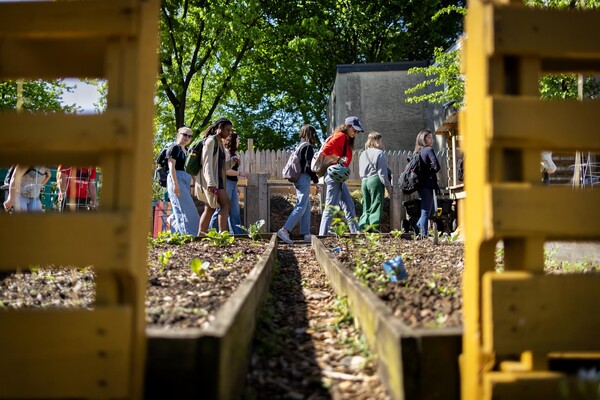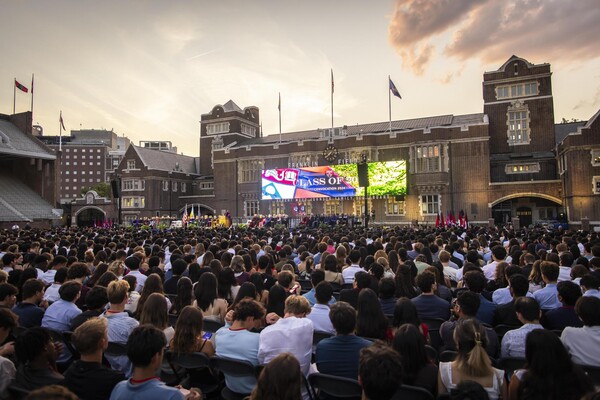Weiss Pavilion is open to faculty, students, staff and alumni
Freshman lacrosse player Lizzy Price spots teammate Caroline Bunting in the Weiss Pavilion’s new 20,000-square-foot weight room and strength and conditioning center for student athletes.
Earlier this spring, students, faculty, staff and alumni were given a new place to pump up, stretch out and de-stress as they gaze at the Center City skyline and the site that will soon become Penn Park.
The Robert A. Fox Fitness Center, located inside the concourse level of the new George A. Weiss Pavilion at Franklin Field, opened to exercisers in May. With more than 8,000 square feet of workout space, the two-story fitness center offers an east campus alternative to the Pottruck Center.
Amy Wagner, director of recreation, says current members of Penn recreation facilities can now use the new fitness center. New memberships, sold at Pottruck, are also available.
“This will take a bit of pressure off the Pottruck Center,” Wagner says, explaining that she expects about 2,000 people a day to use the cardio equipment, free weights and circuit training machines at the Fox Center. The Center offers group circuit training classes as well as sessions with personal trainers, Wagner says.
Through Sept. 7, the Fox Center is open Monday to Friday, 7 a.m. to 8 p.m., and closed on weekends. During the academic year, the Center will be open from 6 a.m. to 11 p.m. on weekdays, and from 8 a.m. until 8 p.m. on weekends.
Built into the existing north side of the stadium, which was constructed in 1925, the $26.9 million Weiss Pavilion project made use of the grand archways in the building’s original design by creating a bank of grand picture windows, each of which measures about 75 feet high and 25 feet across. The windows fill the center with natural light.
Because the space is long and narrow—about 30 feet wide—the decision was made not to include locker rooms in the Center. Wagner says visitors can use the men’s and women’s locker and shower facilities in nearby Hutchinson Gymnasium.
Stacey Jones and David Murphy, who both earned master’s degrees in architecture from Penn’s School of Design in 1988, led the team from Crawford Architects of Kansas City that designed the Pavilion. The Hunter Roberts Construction Group of Philadelphia managed the Pavilion project, working alongside University Architect David Hollenberg, Director of Design and Construction Management Edward J. Sidor, and Project Manager Jim Palka.
Overall, Sidor says, the Pavilion project proceeded smoothly, despite a small setback during the recent autumn rainstorms to correct the drainage system on the north side of the stadium.
“Still, in a historic building like that, where you are bound to find and uncover unforeseen conditions, the project went really well,” he says, adding that the Pavilion is also environmentally friendly, achieving a silver LEED green building rating.
“I’m really proud that we were able to add 52,000 square feet of space without increasing the footprint of the building,” Sidor says.
One of the most notable occurrences during construction was when the team discovered that a city street at the base of Franklin Field had been filled in with 25 to 28 feet of dirt. By excavating the area, crews were able to uncover about 20,000 square feet of additional space, which eventually became the site for a state-of-the-art intercollegiate strength and conditioning center.
The new space provides Penn athletes with five times the room they previously had for weight training and physical conditioning—literally.
“Our old room was 4,000 square feet,” says Michael Diorka, associate director of recreation and athletics, “now we have 20,000 square feet.” Enough space, he says, to accommodate 100 athletes at once.
In addition to 30 weight racks with the same brand of Turkish weights used by athletes at the Beijing Olympics, the conditioning center includes a multipurpose room outfitted with 18 heavy bags, a four-lane rubberized sprinting track and television monitors on which the students can watch game highlights, exercise demonstrations and motivational speeches. Only athletes will be allowed to use the conditioning center.
Read more about the Weiss Pavilion in the Philadelphia Inquirer.







